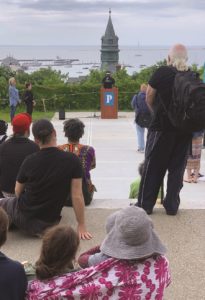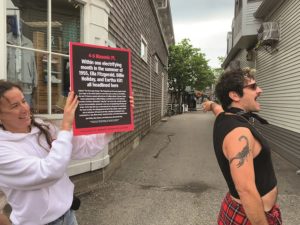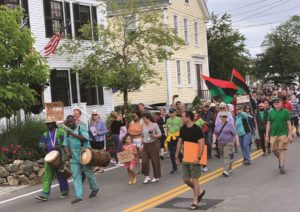PROVINCETOWN — Activists, vacationers, local residents, a handful of elementary school students, community elders, drag queens, religious leaders, business owners, and a few politicians gathered at the base of the Pilgrim Monument on Saturday morning to celebrate Juneteenth.
“We are here at the Pilgrim Monument celebrating the abolition of slavery,” said Aaron Clayton of Provincetown and Los Angeles, an event planner who was one of the key organizers. Clayton, like many other speakers, touched on the tension inherent in that juxtaposition: what does it mean to host an event celebrating Black history at a site that honors colonialism?
Other speakers included Steven Peters, a member of the Wampanoag tribe; Unitarian Pastor Brenda Haywood; Donna Walker, a Provincetown activist; state Sen. Julian Cyr of Truro; and Nath’allia, Shakira, and Georgina — three students from the 5th-grade class at Provincetown Schools, who recited Amanda Gorman’s “The Hill We Climb” from President Biden’s inauguration.

The speakers stood at a podium set at the edge of the hill with Cape Cod Bay behind them. As they spoke, the sun struggled to peek from behind the clouds into an overcast sky. And as Qya Cristál sang “I Know Where I’ve Been,” the pan-African flag was raised.
Two hundred fifty miles away, the same flag was raised on Fire Island, N.Y. In his speech, Clayton explained that the event in Provincetown was happening in partnership with another Juneteenth event there: the Black and Brown Equity Coalition hosted a “beach solidarity” march with people from both ends of the island meeting in the middle to honor Black lives.
Juneteenth celebrates the liberation of enslaved people in Texas on June 19, 1865 — almost two and a half years after President Lincoln issued the Emancipation Proclamation. It was not until some 2,000 troops arrived in Galveston, Texas on that June day that enslaved people in Texas were set free.
Even then, many enslavers withheld information from the enslaved until after the 1865 harvest season was over. But for the hundred thousand or more people liberated, it was a day of joy, and, throughout the state, celebrations broke out that evening.
“Juneteenth is something to celebrate because it’s when people felt a sense of liberation that they thought would never come about in their lifetime,” said Lamb Rahming, a member of Men of Melanin Magic, a Boston group that creates social spaces for queer men of color and was one of the co-hosts of Saturday’s event.
This year, President Biden declared Juneteenth a national holiday.
“No one asked for Juneteenth to be a national holiday,” Rahming said in his speech. “What we asked for was for the police to stop killing us.”
He continued with a list of demands that included equity in education, that trans women of color have a life expectancy beyond 35 years, for common-sense gun laws, and for a health-care system that provides health and not stress. Rahming concluded, “What we asked for is for Black lives to matter. Period.”
“It’s great to have a paid day off,” Rahming told the Independent later, but said he worries about victories that are, as Julian Cyr put it in his speech, “symbolism instead of substance.”
“I don’t want people to lose sight of the work that needs to be done,” Rahming said.
While many of the older speakers commented on how much things have progressed since their childhoods, the three 5th-graders, all of them young women of color, talked urgently about how “hatred of people of color” has made their contemporary childhoods arduous and confusing.

A similar tension was present in the walk down Commercial Street that followed the speeches. Was it a march or a protest? Clayton explained that it was something in between. There was a joyful parade led by two African drummers. And, along the way, people stood near buildings that are historic landmarks of Black life in Provincetown. The walk served as both celebration and education.
The sites were shown on a map put together by David W. Dunlap, a journalist who researches the history of Provincetown through its built environment.
Among other sites, the map demarcates 31 Pearl St., which, in the ’80s, was a bed-and-breakfast for “sisters of color,” and 83 Commercial St., where the concert artist, actor, civil rights activist, and Communist Paul Robeson performed in 1925.
That same year, the Klu Klux Klan, promoting hatred of the Portuguese, burned a 14-foot cross within view of St. Peter the Apostle Church. The map also includes the Atlantic House, where, in the summer of 1955, Ella Fitzgerald, Nina Simone, and Billie Holiday all performed, as well as several other places where historically significant Black artists have displayed their works.
Several of the stops on the map are places rumored to have been part of the Underground Railroad. Garret McDonnell, a graphic designer who adapted Dunlap’s map into signs for the event, noted that those stories could be folklore perpetuated to make white Northerners appear less complicit in American racism.

“What many historians posit,” McDonnell told the Independent, is that such Underground Railroad stories serve to preserve “the idea of the ‘nice Northerner.’ ”
Rahming spoke about the continuity of Black history, culture, and business in Provincetown and emphasized how, instead of being marginal, the Black community is actually the backbone of Provincetown right now.
“I believe the Jamaican community of Provincetown is the lifeblood of the community,” said Rahming. “There should be more opportunities for them to be in the forefront of several industries that, without them, would be nothing.” Changes like that, Rahming said, would be where substance begins to outweigh symbolism.



